Work resignation letter template
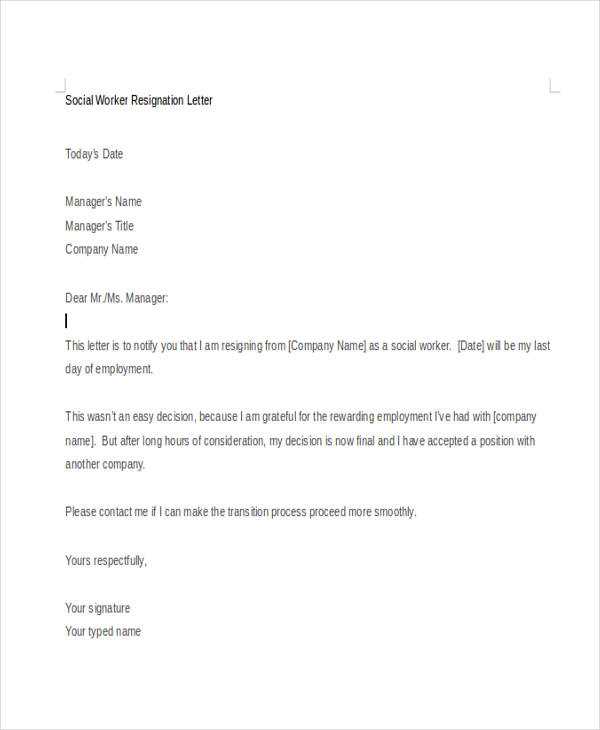
Crafting a resignation letter can be straightforward. Keep it short and to the point, while maintaining a professional tone. Avoid excessive detail about your reasons for leaving; instead, focus on gratitude and a smooth transition.
Start with a clear statement of your intention to resign. Include your position, the company name, and your planned last working day. Being specific about your timeline helps avoid confusion.
Express appreciation for the opportunity. Even if the job wasn’t a perfect fit, thank your employer for the experiences you gained. This leaves a positive impression and helps maintain a good relationship for the future.
Conclude by offering to assist with the transition. Whether it’s training a replacement or helping wrap up your projects, showing your willingness to help can leave a lasting positive impression.
Here’s the Revised Version:
Keep your resignation letter simple, clear, and professional. Focus on expressing gratitude, providing the necessary details, and offering assistance during the transition. Here’s a streamlined template:
- Start with a clear subject line: “Resignation Letter” or “Notice of Resignation”.
- State your intention to resign: Mention your last working day, providing at least two weeks’ notice.
- Express gratitude: Acknowledge the opportunity you had to work with the company and appreciate the experience gained.
- Offer to help during the transition: Suggest how you can assist in handing over your duties or training a replacement.
- End professionally: Close with a statement like, “I wish the team continued success” or “I look forward to staying in touch”.
Here’s a concise example of what your letter could look like:
Subject: Resignation Letter - [Your Name] Dear [Manager's Name], I am writing to formally resign from my position as [Job Title] at [Company Name], with my last working day being [Date]. I truly appreciate the opportunities for professional and personal development that you have provided me during my time here. It has been a pleasure working with the team. I am happy to assist with the transition in any way I can, including training my replacement or helping with the handover of my duties. Thank you once again for the opportunity. I wish you and the company all the best. Sincerely, [Your Name]
Adapt this template based on your situation, and ensure it reflects a positive and respectful tone. Keep it brief, focusing on the key points without over-explaining.
- Work Resignation Letter Template
Begin your resignation letter by clearly stating your intent to resign. Specify your last working day, ideally giving at least two weeks’ notice. This helps maintain professionalism and allows the employer time to adjust.
Next, express gratitude for the opportunities provided during your time at the company. Keep this part brief and sincere. It’s important to remain respectful, even if you have concerns or reasons for leaving.
Provide a short explanation of your reasons for resigning, but avoid going into unnecessary detail. Keep it concise and focus on your future career goals or personal reasons.
Offer assistance with the transition process. This can include helping train a replacement or completing ongoing projects to ensure a smooth handover.
Conclude by thanking your employer again and expressing well wishes for the company’s future success. Sign off professionally, using your full name and job title.
Begin with a clear statement of resignation. Mention your position and the company name. Keep this section brief and direct.
Example: “I am writing to formally resign from my position as Marketing Manager at XYZ Company.”
Next, specify your notice period. This is important to show respect for your employer’s time and to allow for a smooth transition. Refer to the terms in your contract, if applicable.
Example: “As per my contract, my last working day will be [date], providing the standard two weeks’ notice.”
In the following section, express gratitude. Acknowledge the opportunities you’ve had and the positive experiences. Keep this section sincere and professional.
Example: “I want to thank you for the opportunity to work with such a talented team. I’ve learned a lot and appreciate all the support during my tenure.”
Lastly, offer assistance in transitioning. This demonstrates your willingness to help the company even after your departure.
Example: “I am happy to help train a replacement or assist in any other way to ensure a smooth handover.”
Finish with a formal closing. Sign off with appreciation and maintain a positive tone to preserve a good relationship for future references.
Example: “Thank you again for the experience. I wish the company continued success in the future. Sincerely, [Your Name].”
Clearly state your intention to resign from your position. This should be concise and direct.
- Notice Period: Mention the date when your resignation will be effective, along with your last working day. This helps your employer plan for a smooth transition.
- Reason for Leaving: It’s courteous to briefly explain why you’re resigning, whether for personal growth, new opportunities, or another reason. Be professional and avoid unnecessary details.
- Gratitude: Express appreciation for the opportunities you’ve had during your tenure. Acknowledge how the role has contributed to your growth.
- Offer Assistance: Show willingness to help during the transition period by offering to train a replacement or finish pending tasks.
- Professional Closing: End with a polite and positive note, wishing the team and the company success in the future.
The best time to submit your resignation letter is typically two weeks before your intended departure date. This allows your employer adequate time to prepare for your absence and begin the process of finding a replacement.
Consider Your Contractual Obligations
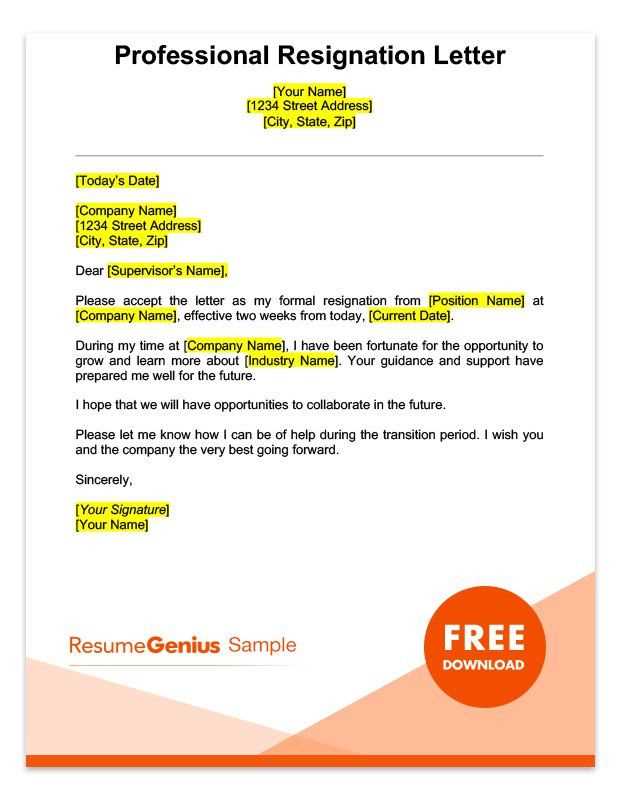
Review your contract or company policies regarding notice periods. Some companies may require more than two weeks’ notice, especially in senior or specialized roles. Adhering to these terms demonstrates professionalism and helps maintain positive relationships with your employer.
Timing and Workplace Environment
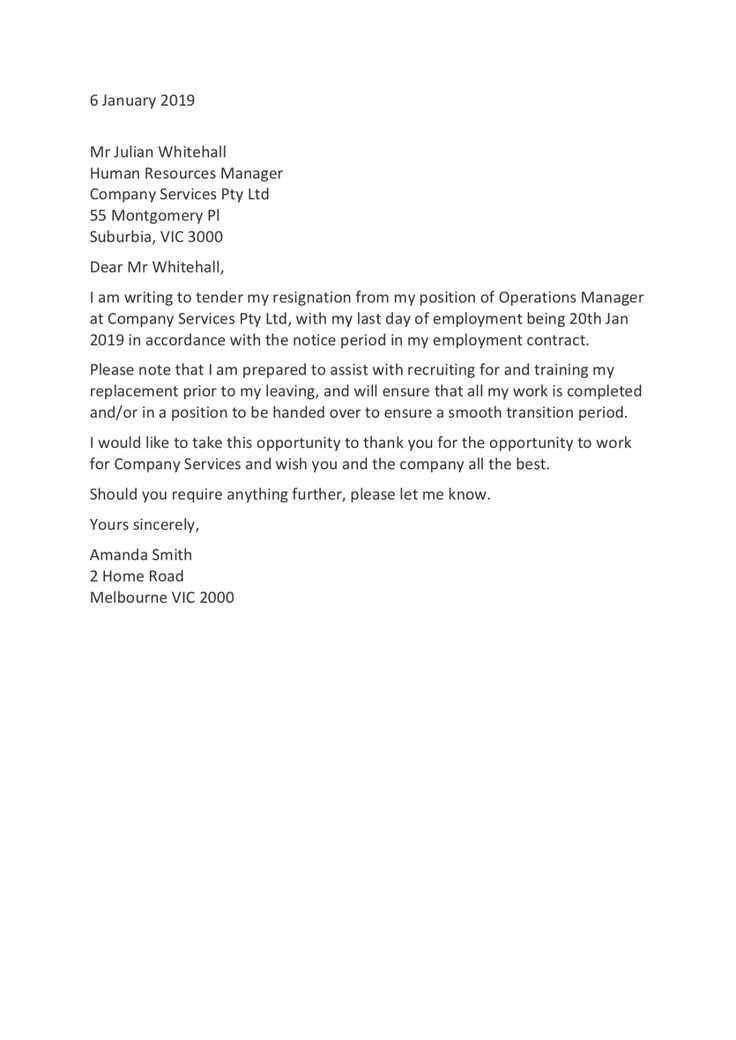
Timing your resignation around key business events or projects can make the transition smoother. Avoid submitting your resignation during crucial periods, such as project deadlines or team events, unless it’s unavoidable.
Begin by expressing gratitude. Acknowledge the opportunities you’ve had in your role and how they have contributed to your growth. This sets a respectful tone from the start and leaves a positive impression.
Focus on What You’ve Learned
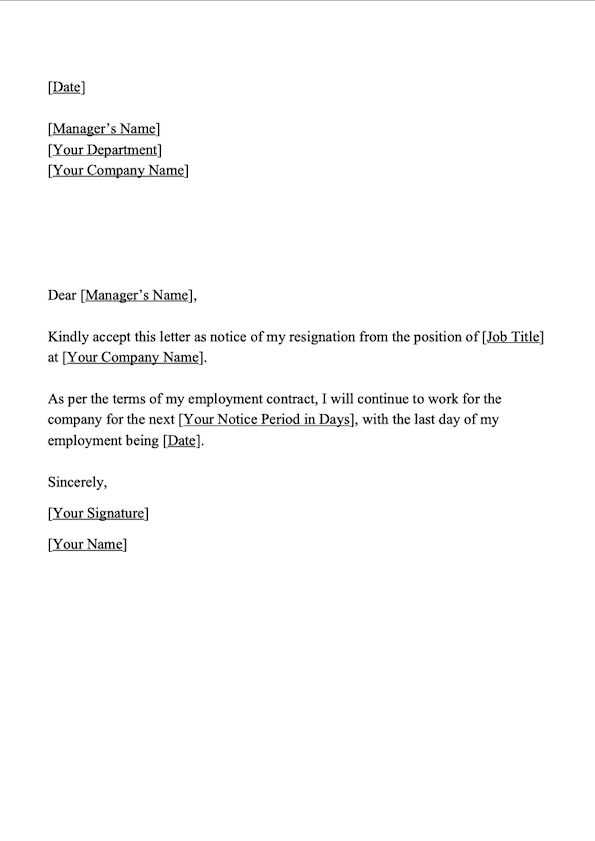
Highlight the skills and knowledge you’ve gained while working with the company. This shows that you appreciate the experience, even if you are moving on to something else. Keep your statements specific and avoid vague generalizations.
Offer Help During the Transition
Make it clear you are willing to assist with the handover process. Whether it’s training your replacement or tying up loose ends, offering to help shows your commitment to the company’s success, even after your departure.
| Positive Phrases to Use | Negative Phrases to Avoid |
|---|---|
| “I am grateful for the opportunities” | “I’m unhappy with the company” |
| “I have learned valuable skills” | “I didn’t gain anything from this job” |
| “I am happy to help with the transition” | “I’m leaving because things didn’t work out” |
By focusing on your positive experiences and offering your support, you ensure that your resignation letter leaves the right impression, paving the way for a smooth and professional exit.
When drafting your resignation letter, it’s key to tailor it to your specific situation. A simple, clear approach works best, whether you’re leaving for another job, personal reasons, or retirement.
Resignation for a New Job Opportunity
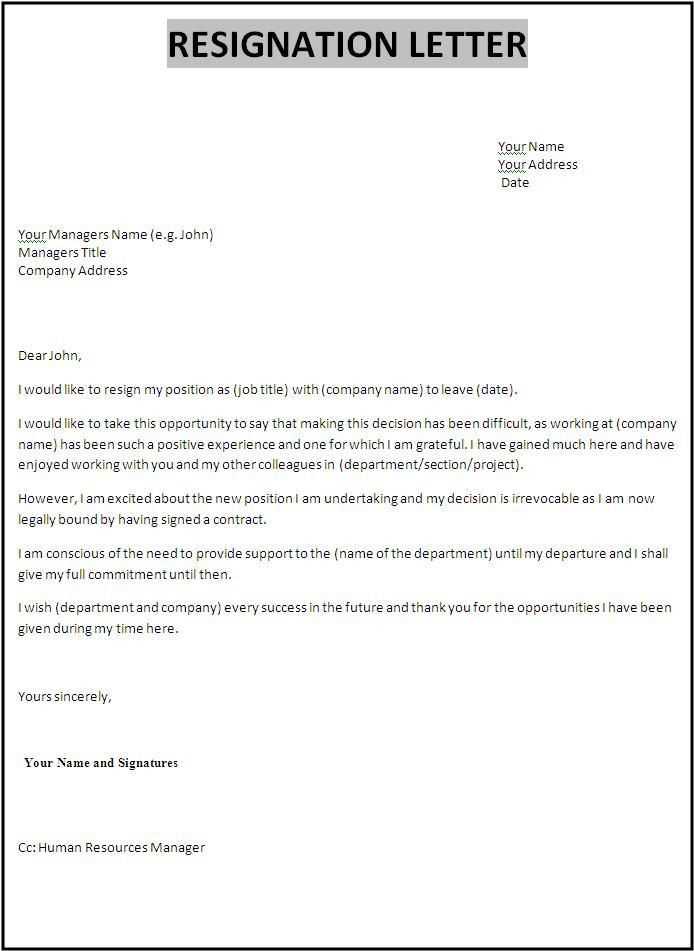
In this case, highlight your excitement for the next step while maintaining professionalism. Keep it concise and positive.
Example:
Dear [Manager’s Name],
I am writing to formally resign from my position as [Your Job Title] at [Company Name], effective [Last Working Day]. I have accepted an offer for a new opportunity that aligns with my long-term career goals. I appreciate all the support and guidance provided during my time here. I look forward to maintaining our professional relationship.
Resignation Due to Personal Reasons
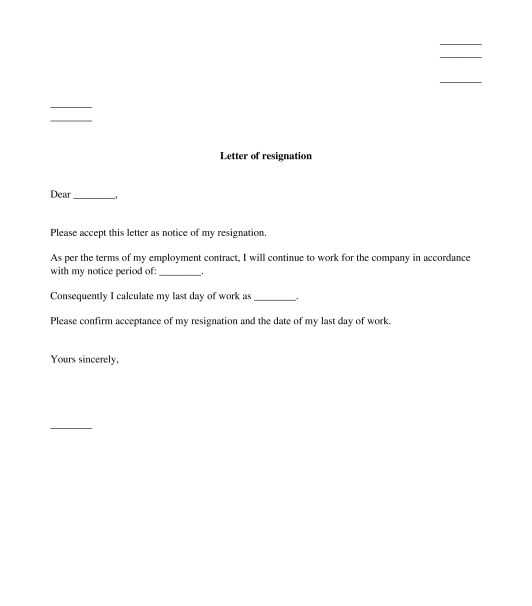
If personal matters are behind your decision, express gratitude for the time spent and be straightforward about your need to move on. You do not have to go into detail about the reasons for your departure.
Example:
Dear [Manager’s Name],
After careful consideration, I have decided to resign from my position as [Your Job Title] at [Company Name], effective [Last Working Day]. Personal reasons have led me to this decision, and while I am grateful for my time at [Company Name], I believe this is the right choice for me at this moment. I’m grateful for the experiences I’ve gained and look forward to staying in touch.
Each resignation letter serves a specific purpose, so adjust your tone to reflect your circumstances and ensure your departure is professional and amicable.
Avoid leaving your resignation letter too vague. Clearly state your intent to resign and include your last working day. This helps avoid any confusion with your employer and ensures smooth communication.
Do not include negative or critical comments about the company, colleagues, or management. Even if your experience was less than ideal, keeping the tone neutral and professional maintains your reputation and prevents burning bridges.
Be specific about the timeline. Failing to provide a clear notice period can lead to misunderstandings and could affect your professional relationship. Mention the exact date of your last day to avoid any ambiguity.
Don’t forget to express gratitude. Leaving out a brief acknowledgment of the opportunities you had during your employment may come off as unappreciative. A simple thank you goes a long way.
Steer clear of informal language or overly casual phrasing. Your resignation letter should maintain a level of professionalism, even if you have a friendly rapport with your employer. Keep it respectful and formal.
When creating a work resignation letter, focus on clarity and conciseness. Your letter should be respectful but direct. Begin with a formal statement of resignation, stating the position and the last working day. This will set a professional tone and avoid misunderstandings.
Here’s a simple structure you can follow:
| Section | Description |
|---|---|
| Opening | State your resignation clearly, including the position and your final working day. |
| Reason for Resignation | If you feel comfortable, briefly mention your reason for leaving. Keep it positive and professional. |
| Appreciation | Express gratitude for the opportunity to work with the company, even if your experience was mixed. |
| Transition Details | Offer assistance with the transition, if appropriate. This can help maintain goodwill. |
| Closing | End on a positive note, wishing the company continued success. |
By following this structure, you’ll ensure your resignation is clear, professional, and respectful, which helps maintain a good relationship with your employer.